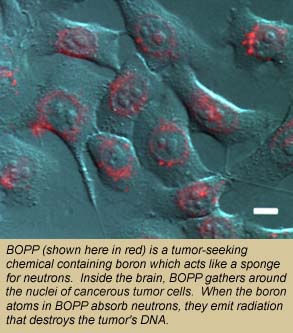
- A PRESCRIPTION FOR HOPE PART 4 -
The ESQ is being developed under the leadership of
AFRD physicist Joe Kwan. Although another type of accelerator, a Radio
Frequency Quadrupole (RFQ), is already being successfully used in
hospitals for other types of radiation therapies, Kwan says an ESQ
accelerator is the best choice for BNCT at this time. "An ESQ accelerator with its exceptionally high-currents will reduce
patient treatment time (because of the high yield of neutrons) which
means (among other advantages) that a greater number of patients can be
treated." According to Kwan, it has been estimated that patient treatment time
would be less than one hour with a 100 milliamp proton beam at 2.5 MeV.
BNCT treatments involving nuclear reactors generally last much longer.
In addition to the accelerator itself, an accelerator-based BNCT
system also needs a neutron production target, and a moderator and
filter assembly for shaping the neutrons into a clinically useful beam.
Although there are a number of good candidates, Berkeley researchers
have chosen lithium as their target because it offers the highest yield
of suitable neutrons. The electrical neutrality that enables neutrons to penetrate atomic
nuclei also makes shaping them into a beam a tricky proposition. Unable
to use the electromagnetic fields that focus and direct protons or
electrons, scientists must depend upon more elaborate gimmicks in which
neutrons are directed into certain materials that can influence their
flight paths and energies. These materials, however, can create their
own sets of problems. Explains Chu, "Neutrons can lose energy very fast in water or
plastic, scatter a lot in other materials, or stop altogether in still
another kind of material. Not only must we shape the beam energy and
profile, we must do so without making too many extraneous photons
(x-rays) or leaving residual fast (high energy) neutrons." To accomplish this, LSD physicist Bernhard Ludewigt, along with Rick
Donahue, from the Environmental Health and Safety Division, and UC
Berkeley nuclear engineering grad student Darren Bleuel have come up
with a three-stage system involving a moderator, a reflector and a
collimator. The moderator, a block of material such as aluminum
fluoride, is placed downstream from the target; the reflector, a block
of aluminum oxide, is placed upstream. When the proton beam bombards
the target, neutrons fly off in all directions at energies ranging from
200 to 800 keV. Forward-moving neutrons directly strike the moderator;
backwards-moving neutrons are reflected into it. The moderator slows
these neutrons down or "moderates" them to the 20 keV or lower energies
required for safe BNCT. Further downstream from the moderator is the
collimator, a block of plastic with a hole that faces the patients
brain. Epithermal neutrons swarm into the collimator but emerge out of
the hole in an orderly fashion as a beam that shines
"The neutron beam energy can be shaped to reach deep-seated tumors,"
says Ludewigt, "so that we can place 50-percent more dose in the middle
of the tumor than what can be achieved with neutrons from
reactors." As stated earlier, the success of BNCT also depends upon the
selectivity of the boron-carrying compound. The clinical trials now
taking place at BNL have been approved by the Food and Drug
Administration (FDA) to be conducted with two compounds that were
developed in the late 1950s and are not viewed as ideal. Recently, UCSF
Professor Stephen Kahl developed a compound called "boronated
(proto)-porphyrin" or BOPP, which has shown promise in various animal
studies. For any such compound to be effective, the crucial
requirements are that it be able to slip past the brains blood barrier,
that it concentrates in tumors, and that it rapidly clears from healthy
brain cells and the blood system. "In animal studies (mice and dogs), the ratio of BOPP in tumors and
healthy cells was greater than 100 to one, and it cleared sufficiently
fast from the blood," says Kahl. "BOPP is also better than 30-percent
boron by weight (each BOPP molecule contains 40 atoms of boron) and
highly water soluble which should make it safer and more effective than
the old compounds."
